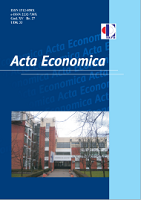STOCHASTIC ASPECTS OF CONTINUOUS IMPROVEMENT OF THE BUSINESS RESULTS PERFORMANCE OF THE PUBLIC ADMINISTRATION
STOCHASTIC ASPECTS OF CONTINUOUS IMPROVEMENT OF THE BUSINESS RESULTS PERFORMANCE OF THE PUBLIC ADMINISTRATION
Author(s): Mirjana Landika, Sanel Jakupović, Radmila Bojanić, Velibor Peulić, Vedran Šupuković, Wolfgang BergerSubject(s): Business Economy / Management, Public Administration
Published by: Економски факултет Универзитета у Бањој Луци
Keywords: business excellence; effective operation; unwanted result; stochastic manifestation; probability distribution; performance improvement;
Summary/Abstract: Effective operation of a system is expressed as an aspiration to achieve excellence in business results, recognized as total elimination of prevented difference between desired values and actual values of the realized system performance, requiring identification of both environmental and internal factors, as well as an explicit expression of the form and the extent of their impact on business processes. It is heavily laden by stochastic manifestation of their values and complexity of the influence. Optimal business management is determined by the structure and the concept of the system operation, and it is expressed and measured by the extent to which a business result meets user requirements. Realization of business objectives is contained in the performance of an output vector, being a resultant of actions of the business system, in terms of separate task stages in public administration management, and also in the operation of the system as a whole. Elimination of unwanted results involves interdependence, conditioning, frequency and probability distribution of their occurrence, and also coordination of, and cooperation between, numerous resources required to achieve the desired level of operational efficiency. Testing the reagibility of realized level of customer (dis)satisfaction with the performance of administrative services, as a dependent variable, in terms of level and intensity, manifested forms of used protocols and adequacy of service provider engagement, as an input of the variable, and their expression by means of an appropriate statistical function represents the aim of research, i.e. improvement of business efficiency by means of exact results. The aforementioned procedures facilitate anticipation and correction of business results, and despite the stochastic process performance variations which are analyzed and monitored, their behavior is predicted, controlled and rationally directed towards a desired business result. The design of experiment is based on time disproportion in discovering the causes of realized level of subjective perception of satisfaction when satisfying the demand in terms of administrative services, and in the context of frequency of demandand the form of service requested. By overcoming and eliminating dissatisfaction with the performance of services, business efficiency of administrative process results is being significantly and permanently improved and the degree of employees’ satisfaction is intensified; the same is with the service users, whose final result minimizes differentiality of realized and targeted performances, and simultaneously the global optimum of the social-economic system. The conclusion in terms of the existence of intensive connections between the observed phenomena reveals the causes of the achieved level of output performance and facilitates its indirect correction by dosing the structure and intensity of the input vector.
Journal: Acta Economica
- Issue Year: 17/2019
- Issue No: 31
- Page Range: 35-50
- Page Count: 16
- Language: English

